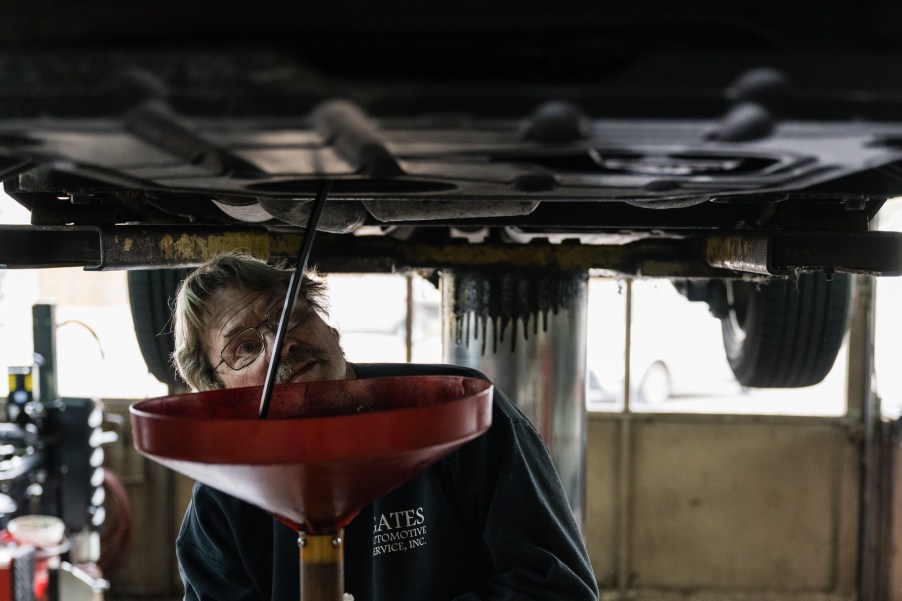
5 Oil Change Mistakes to Avoid Making Next Time You Change Your Car’s Oil
When it comes to car maintenance, there are some simple tasks that you can either do yourself or sometimes get done for free with a purchase, like replacing windshield wipers. However, other maintenance items require a professional’s touch along with their hourly rate. A typical oil change overlaps these two realms in that many car owners rely on a professional service, but the task is DIY-friendly with a few simple tools as long as you avoid these common mistakes.
Mistake #1: Not preparing your tools and materials
First, you’ll need a jack and jack stands or ramps to raise your car enough to shimmy under it safely. Consult your car’s owner’s manual for instructions. While you have the manual out, read through the maintenance section and note your car’s oil capacity, type, and recommended change frequency.
When you buy the new oil and filter, pick up an oil drain pan with a lid and spout so you can pour your old oil back into the containers the new oil came in to recycle it. Next, you’ll need the correct size wrench to remove the drain plug. The proper wrench could be a combination wrench, a socket wrench, or an Allen wrench. Searching for info on DIY oil changes for your car will answer many of your car-specific questions.
You’ll also need an oil filter wrench. Two basic types include a strap wrench and the kind that fits the end of your car’s oil filter. They aren’t expensive, and having both types on hand can be a project saver. For stubborn filters, a pair of oil filter pliers come in handy.
Finally, a selection of old rags, a roll of good paper towels or some “shop-specific” towels, safety glasses, and disposable rubber gloves should complete your preparation, unless you’re lying on a dirty floor or driveway. In that case, you’ll want some cardboard underneath you.
Mistake #2: Failing to lubricate the oil filter gasket
Once you’ve drained the old oil into the drain pan and removed the old oil filter, it’s time to put on the new oil filter. First, use a rag to clean the area on the engine where the new oil filter gasket will sit and ensure the old rubber gasket came off with the old filter. Then, before installing the new oil filter, take some clean engine oil on a rag or a gloved finger and spread it on the new oil filter’s rubber gasket. Lubrication will allow the rubber gasket to slide as you tighten the filter without wrinkling.
Mistake #3: Forgetting to tighten the oil drain plug
Before installing the drain plug, use a rag to remove residual oil and inspect the washer. Most cars in the U.S. use a reusable washer, but some vehicles may require a replacement. Once satisfied, reinstall the drain plug and tighten it to your car’s specifications. Failure to properly tighten the drain plug could damage your oil pan if over-torqued. And as stated by Autobytel, “Overtightening will just cause you problems when it comes time to remove the filter or drain plug.”
Mistake #4: Not adding the proper amount of oil (or any at all)
Every engine requires a specific amount of oil. Once the drain plug and new oil filter are in place, pour the specified amount of new oil into the oil filler hole. More than one engine failure owes its demise to a mechanic forgetting this step.
Mistake #5: Leaving the oil filler cap off
After filling the engine with the correct oil, don’t forget to replace the oil filler cap. Leaving the cap off allows oil to spew out of the filler hole into the engine compartment, covering every surface under the hood and even the front tires with grimy engine oil.
Is it worth doing an oil change yourself?

Many people who perform their car maintenance and repairs find a sense of pride in their capabilities, knowing they accomplished the task correctly. Like them, you could also find it cheaper to do an oil change yourself. Doing an oil change yourself ensures you receive the quality components you paid for without question. However, a DIY oil change today could lead to coolant flushes, changing spark plugs, and brake jobs in the future if you’re not careful.



